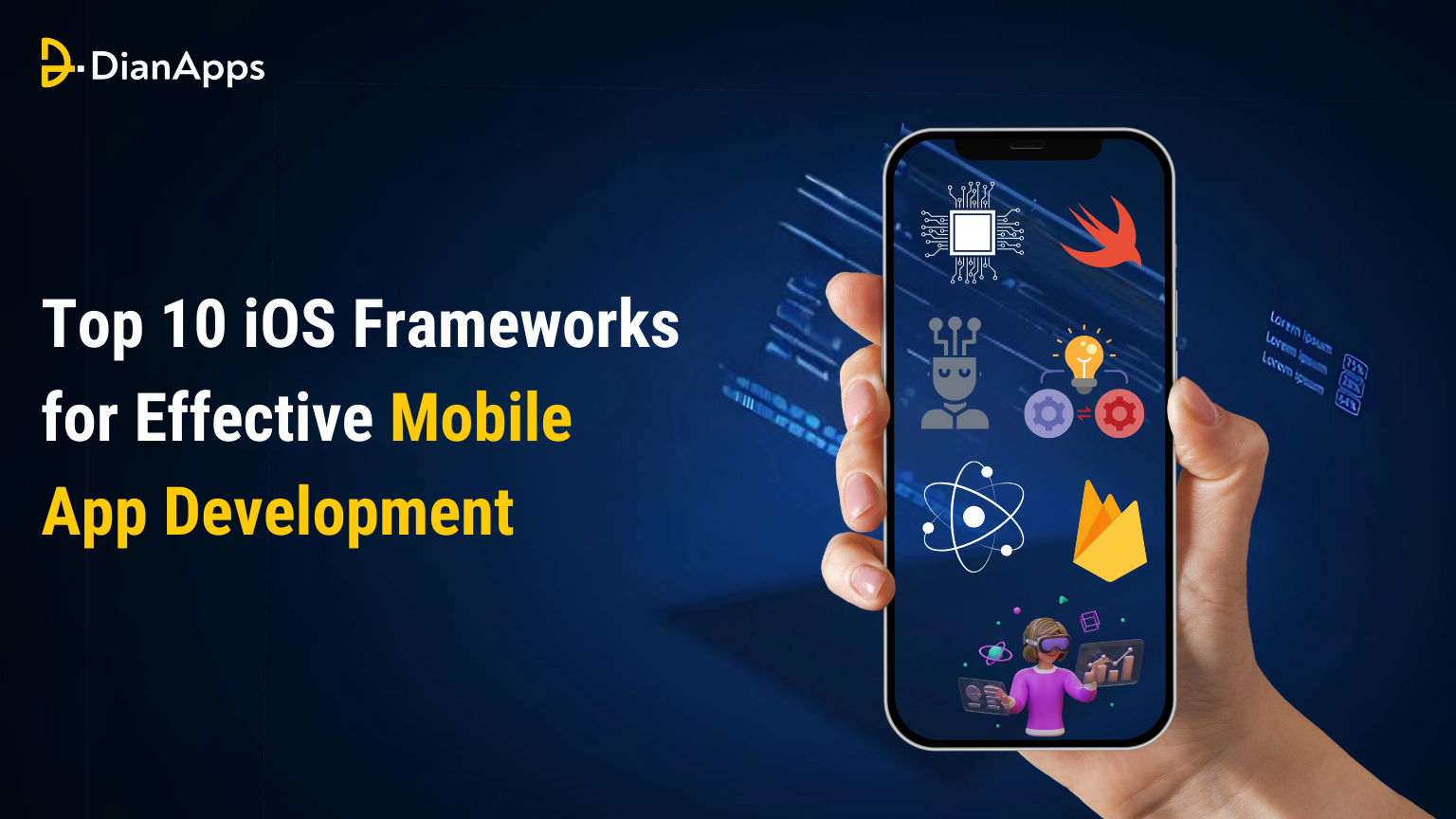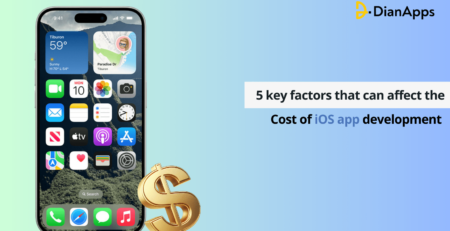Top 10 iOS Frameworks for Effective Mobile App Development 2025
In 2025, mobile app development continues to soar, with over 2.8 million apps available on the Apple App Store, generating millions of dollars in revenue. With the constant demand for high-performance, feature-rich apps, developers are turning to advanced frameworks to streamline the development process.
One such framework that has gained considerable traction in 2025 is SwiftUI, Apple’s innovative user interface framework that allows developers to design apps faster, with cleaner and more efficient code.
SwiftUI has revolutionized how developers approach app design, enhancing productivity and ensuring apps are built to run smoothly across all Apple devices. SwiftUI, combined with other robust iOS frameworks, is shaping the future of app development services, offering faster development cycles, better performance, and improved user experiences.
As mobile app development continues to evolve, selecting the right frameworks is crucial to stay competitive. Frameworks like SwiftUI, Core Data, and Alamofire have become essential tools for developers looking to meet the needs of today’s dynamic app market.
Let’s explore the top 10 iOS frameworks that are defining the landscape of mobile app development in 2025.
Before we dive into the frameworks, let us understand the key differences between Android and iOS app development!
Why iOS Frameworks Matter?
In iOS app development, frameworks are the foundation upon which successful mobile applications are built. These powerful tools provide pre-written code libraries, functions, and resources, which simplify the development process, saving developers significant time and effort.
Instead of building every feature from scratch, developers can leverage these frameworks to handle repetitive tasks like user interface design, data management, and network communications, ensuring apps are created efficiently and with fewer errors.
Frameworks also ensure consistency and high-quality user experiences. With built-in solutions for performance optimization, security, and compatibility across various devices, frameworks guarantee that apps meet Apple’s stringent standards, creating smooth, stable experiences for end users.
Furthermore, using well-established frameworks enables iOS app development services to stay ahead of industry trends. They are constantly updated to align with the latest iOS releases, so developers can incorporate cutting-edge features into their apps.
This ensures that apps stay competitive in a rapidly evolving market, offering functionality such as augmented reality, real-time data synchronization, and seamless integration with other Apple products.
By utilizing these frameworks, developers can also speed up the development cycle, reducing time to market and allowing businesses to adapt to changing customer needs faster.
With the right framework, iOS app development can focus on delivering innovation while relying on robust and trusted tools to handle the technical complexity.
Criteria for Choosing the Right Framework
Selecting the right iOS framework is a critical decision that can significantly impact the success of an app. With a multitude of options available, it’s essential to consider several factors such as tools, benefits, and practices to ensure the chosen framework aligns with your project’s goals, timeline, and technical requirements. Here are the key criteria to consider when choosing the best iOS framework for your app:
1. Performance and Efficiency
A framework’s performance is one of the most crucial factors in choosing the right one. Ensure that the framework can handle the complexity of your app without slowing down or causing lag, especially when dealing with resource-intensive tasks like animations, real-time data, or gaming features. Frameworks like SwiftUI and Core Animation are known for their performance optimization, making them ideal choices for fast, responsive apps.
2. Ease of Use and Learning Curve
Consider the learning curve and developer expertise required to implement a framework. Some frameworks, like UIKit, may be more complex and suited to experienced developers, while newer frameworks like SwiftUI are designed to be more intuitive and beginner-friendly. Choose a framework that aligns with your team’s skills and knowledge to avoid extended development time and unnecessary complications while enable you develop an iOS app in just 45 days!
3. Scalability
As apps grow, so does the need for scalability. Ensure the framework you choose can handle future updates and app expansion without significant rework. Frameworks like Core Data offer robust data management solutions that can scale with your app as it grows, making it easier to add features or manage large amounts of data over time.
4. Compatibility and Integration
Your chosen framework should seamlessly integrate with the tools and technologies used in your app. Check for compatibility with other essential components of your app, such as databases, third-party APIs, or external libraries. Frameworks like Alamofire and Firebase SDK are widely compatible with various back-end services and help developers efficiently manage networking and cloud storage.
5. Community Support and Documentation
Frameworks with strong community support and thorough documentation make the development process smoother, providing resources for troubleshooting and problem-solving. Frameworks like React Native and Firebase benefit from vast online communities, where developers share solutions and best practices. The availability of tutorials, guides, and forums can be a game-changer for faster app development.
6. Future-Proofing and Updates
Opt for frameworks that are regularly updated and align with the latest iOS trends. Staying updated with the latest features and security patches ensures that your app remains competitive and secure. Frameworks like ARKit and SwiftUI are backed by Apple and receive frequent updates, making them suitable for future-proofing your app.
7. Security Features
Security is paramount in mobile app development. The right framework should offer built-in security features such as data encryption, authentication protocols, and secure networking. Frameworks like Core Data and Firebase come with integrated security measures that help protect sensitive data and enhance user trust.
8. Cost and Resource Management
Evaluate the costs associated with using a framework. Some frameworks may require paid licenses or subscriptions, while others are open-source and free to use. Additionally, consider the amount of time and resources required for implementation. A framework that is easy to implement may save costs in development time, even if it requires a slightly higher upfront investment.
9. Cross-Platform Capabilities
For businesses looking to target both iOS and Android users, a framework that supports cross-platform development can be a significant advantage. React Native is a popular choice for cross-platform apps, allowing developers to write code once and deploy it on both platforms. This reduces development time and resource allocation.
10. Testing and Debugging Tools
Frameworks with integrated testing and debugging tools help ensure that your app performs well under various conditions. Look for frameworks that offer easy-to-use tools for unit testing, UI testing, and performance analysis. Frameworks like Xcode provide a comprehensive suite of tools for testing and debugging, ensuring your app is bug-free before release.
By carefully considering these criteria, you can select a framework that not only meets your current needs but also positions your app for long-term success.
The right framework will streamline development, enhance app performance, and ensure you stay ahead of the competition in the fast-evolving world of iOS app development.
Read the 5 proven strategies of iOS development applied by top companies!
Top 10 iOS Frameworks for 2025
The world of iOS app development is evolving rapidly, with new frameworks and tools continuously shaping how developers build apps. In 2025, developers need to stay ahead of the curve by leveraging the latest iOS frameworks that maximize efficiency, performance, and user experience. Below are the top 10 iOS frameworks to watch out for in 2025:
1. SwiftUI
SwiftUI is Apple’s declarative framework for building user interfaces across all Apple platforms. Introduced to simplify UI development, SwiftUI allows developers to write less code while achieving stunning results. It’s designed to work seamlessly with Swift, and its declarative nature means developers describe what the interface should do, not how it should do it.
SwiftUI continues to evolve in 2025, making UI design faster, more efficient, and easier to implement. It’s particularly useful for modern apps that need to work across multiple devices with minimal effort.
Also read: How to build your own Blog app with SwiftUI
2. UIKit
UIKit is the traditional framework for building user interfaces on iOS. While SwiftUI has taken the spotlight for new apps, UIKit is still a cornerstone for complex, custom UIs and legacy applications.
Many large-scale, feature-rich apps still rely on UIKit due to its flexibility and maturity. As the backbone of iOS UI development for years, it’s essential for projects requiring fine-tuned, custom design elements.
3. Core Data
Core Data is Apple’s framework for data persistence, allowing developers to manage and store structured data locally in iOS apps. It is highly integrated with the iOS ecosystem and supports complex data models.
In 2025, Core Data’s improvements help developers handle larger datasets more efficiently. The integration with SwiftUI also makes it easier to manage state and data synchronization across apps, making it a must-have for data-heavy applications.
4. Combine
Combine is a framework for reactive programming, providing a declarative Swift API for processing values over time. It is used for handling asynchronous events, such as user input or data updates, and it simplifies the management of complex data flows.
With more apps relying on real-time data and seamless user interactions, Combine’s ability to manage asynchronous operations with minimal code is a game-changer for developers working on apps that require live updates.
5. ARKit
ARKit is Apple’s framework for augmented reality (AR) experiences. It enables developers to create immersive AR applications by leveraging the device’s camera and sensors to detect and track the environment.
In 2025, AR will continue to be a critical feature for apps in sectors like gaming, retail, and education. With ARKit’s enhanced features, including better environmental understanding and support for AR hardware, developers can create highly interactive, realistic AR experiences.
6. Core Animation
Core Animation is a framework for adding high-performance, smooth animations to iOS apps. It supports both 2D and 3D animations, making it an essential tool for delivering visually appealing and responsive apps.
As user expectations for app performance and design continue to rise, Core Animation remains crucial in providing the fluid, high-quality animations that help apps stand out in 2025.
7. Firebase iOS SDK
Firebase is a powerful platform for mobile and web app development, offering a wide range of tools such as real-time databases, authentication, cloud storage, and analytics. The Firebase SDK for iOS provides easy integration with these services.
In 2025, Firebase remains a go-to solution for developers who need to quickly set up back-end infrastructure without worrying about managing servers. Firebase’s features, like real-time syncing and cloud messaging, streamline app development, especially for apps that require scalable, real-time data.
8. Alamofire
Alamofire is a popular Swift-based networking library that simplifies HTTP networking. It offers advanced features like response serialization, image caching, and request chaining, making it easier to handle network operations.
As mobile apps increasingly rely on APIs and external data sources, Alamofire continues to be a top choice for developers who need reliable and efficient networking solutions. Its simplicity and flexibility make it invaluable in 2025.
9. Realm
Realm is an open-source mobile database that offers a simpler, faster alternative to Core Data for data storage and management. Realm supports both iOS and Android, allowing for cross-platform development.
Realm’s focus on ease of use and high-performance data storage makes it a popular choice in 2025 for developers looking for a lightweight and flexible database solution that scales with the app’s growth.
Also read: How to hire iOS app developers!
10. SwiftNIO
SwiftNIO is a high-performance, non-blocking networking framework built for server-side applications. It allows developers to build scalable, event-driven network applications.
With the growing need for real-time, server-driven apps, SwiftNIO’s non-blocking nature makes it ideal for building apps with complex networking requirements, such as chat applications, live streaming, and gaming.
How These Frameworks Enhance Mobile App Development in 2025
As mobile app development continues to evolve in 2025, the frameworks that developers choose play a significant role in determining how efficient, powerful, and user-friendly their applications will be.
Here’s how the top iOS frameworks enhance mobile app development and make a major impact on app creation in 2025:
1. Streamlining UI Development with SwiftUI
SwiftUI, being a declarative framework, has revolutionized UI design by allowing developers to define the interface in a simple, intuitive way.
In 2025, this framework will accelerate app development by reducing the need for repetitive coding, especially when building apps for multiple Apple devices.
By simply describing the desired outcome, developers can let SwiftUI handle the rest, enabling faster development cycles and creating apps with consistent, dynamic user interfaces.
2. Legacy Compatibility and Flexibility with UIKit
While SwiftUI is the future, UIKit remains a cornerstone for building more complex, custom user interfaces. Many iOS apps, especially those with intricate user experiences, still rely on UIKit’s flexibility.
In 2025, UIKit continues to provide the robustness needed for legacy apps while giving developers more room for custom design and UI elements that meet specific business needs, making it indispensable for highly tailored mobile apps.
3. Efficient Data Handling with Core Data
Core Data remains a powerful framework for managing large volumes of data. In 2025, its integration with SwiftUI will enable developers to easily sync data across different views and models.
Core Data’s improved performance in handling persistent data ensures that apps can scale without compromising speed or reliability. This makes it an ideal solution for apps dealing with complex databases, from social media apps to e-commerce platforms.
4. Simplifying Asynchronous Tasks with Combine
With mobile apps needing to interact with various data sources in real time, Combine stands out as the solution for reactive programming. In 2025, it will allow developers to manage complex asynchronous workflows and data streams with ease.
By handling multiple events and notifications in a unified manner, Combine ensures smooth, real-time experiences for users, especially in apps requiring live data updates, notifications, or background processing.
5. Bringing Stunning Animations to Life with Core Animation
High-quality animations are crucial for modern app design. Core Animation is key in delivering fluid and visually appealing animations that keep users engaged.
In 2025, this framework will help developers easily create smooth transitions, interactive elements, and dynamic animations, significantly improving the user experience.
Core Animation empowers developers to make their apps feel polished, enhancing app interaction through visually satisfying effects.
Final Thought
As iOS app development continues to evolve, choosing the right framework is more critical than ever. In 2025, frameworks like SwiftUI, Core Data, ARKit, and Combine are not only streamlining development but also enabling developers to build powerful, feature-rich applications that deliver exceptional user experiences. These frameworks make it easier to integrate complex functionalities, enhance app performance, and create seamless interfaces, all while reducing development time.
Whether you’re creating a simple mobile app or a sophisticated platform requiring real-time data and immersive experiences, leveraging the right set of frameworks is key to building a successful product. Mobile app development services in 2025 are all about staying ahead of the curve, and with these top frameworks, developers can ensure their apps meet the demands of modern users and rise above the competition.
For businesses looking to create innovative and efficient mobile applications, understanding and implementing these frameworks will not only speed up development but also improve app quality and user satisfaction.
The future of iOS development is here—embrace these frameworks and build apps that stand out in 2025 and beyond!




